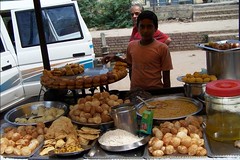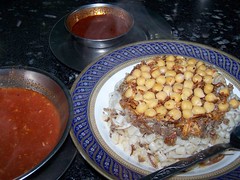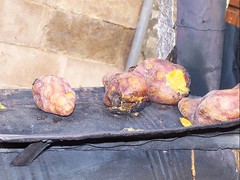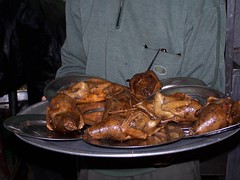When I first considered writing about street food in Cairo, the few people I knew in Cairo had a good laugh and cautioned me that having just arrived in the city I was completely setting myself up for the curse of the Pharaohs. Well, being a desi and with an ability to eat the Pav Bhajis and Paani Puris and Vada Pavs on the streets of India, the streets of Cairo posed no threat at all, so I was all set to explore Cairo by tasting everything it had to offer. (But I did tuck a strip of lomotil into my wallet to be on the safer side.)

There's such a variety of snacks, meals, quick bites and drinks on offer on the streets of Cairo that it would be impossible to try them all in a few days, but I did manage the highlights.
A good day begins with a good breakfast. A fuul or tamiya sandwich is what is considered ideal. I tried these at Arzak in Maadi Grand Mall, from a stall near the Sultan Hassan Mosque and Moqattam courtesy the Pen Temple Pilots and a couple of other street carts. I loved them all. Fuul is paste of cooked fava beans spiced to your liking with maybe a few fresh veggies thrown in too for texture.
The tamiya is a deep fried patty of the same fava beans. But they taste completely different in this form than as fuul. The tamiya is flattened and stuffed into the eish (pita bread) with a little hummus or tahini and more fresh veggies.
My favorite is a little tahini, a little fuul, tamiya and pickled brinjals all stuffed into one sandwich. This makes for a messy eat since the ingredients tend to squish out the sides, but to quote Rachel Ray, it's completely "yum-o!"
These sandwiches can also be stuffed with omelettes, french fries and all kinds of combinations. At 1-2 LE each they are an absolute steal.
It's interesting to watch the sandwich guy stuff the assortment of ingredients into the bread. It reminds me of the anda parathawala outside IIT Delhi who nimbly cracks and throws a raw egg between two layers of a paratha while the paratha is frying on the pan, all in one single flowing movement to produce the most scrumptious anda parathas ever.
I don't think India has a direct comparison in terms of taste for fuul or tamiya. The closest similarity I could think of was boiled and smashed peas which are used as a base in some chaat preparations. Also the tamiya is a bit like a dhalwada.
For lunch in Cairo. I'd go for Koshary. Actually, I can eat this for breakfast, lunch and dinner and never get tired of it. It's considered the common man's food, but I've also heard someone say they think it should be named Egypt's National Dish. A combination of pasta, lentils and tomato sauce topped with fried onions. Its light yet filling, nutritious, quick, healthy and ohhh so tasty. The guy who makes the koshary normally has all the ingredients ready and warm. When an order is placed he mixes it all in a jiffy and its mouth watering to see how he deftly assembles the dish. The crunchy onions on top are better than cherries on a cake.

When it comes to Koshary every single person you meet in Cairo will tell you that they know the "best" place to eat it and everyone claims that their place is better than anywhere else. On recommendations, I've tried Arzak in Maadi , Abou Yoosef in Mohandaseen and street stalls all over the city. Although I loved them all, I must confess I'm a little partial to El Omda's Koshary topped with Chicken Shawrma because it gives me my meat fix too.
Although there's no confirmed Number One Koshary in Cairo, what is certain is that a good hot steaming plate of Koshary can warm the cockles of anyone's heart. Koshary is complete soul food and this is what I will crave the most when the time comes for me to leave Egypt.
For mid meal snacking there are umpteen options all over town: baked sweet potatoes, roasted nuts and seeds. A friend of mine said she would rather buy one roasted sweet potato from the street vendor than a kilo & a half from the grocer for the same price.

They are that delicious. For the thirsty there are a variety of juice stalls to try from. The aaseer asab (sugarcane juice/ghanne da ras) works perfectly to counter the dehydrating effects of Cairo's heat. It replenishes body salts, it's tasty and completely refreshing with a strong natural sugar-fix to it.
By dinner time, most Cairenes are more relaxed and have the time and leisure to wait for a good meal to be prepared. If you find yourself with the time to enjoy a meal, then head down to one of the kebab houses, order your hearts fancy and wait for the wonderful steaming dishes to be brought to your make-shift table on the street.
The two most recommended kebab places are Farhat at Khan el Khalili and Mohammed Rifai at Sayeda Zainab. You can order various meat based items here. Kebabs and kofta are the most popular combination. In Egypt, Koftas are rolled and skewered minced meat with spices. Kebabs are roasted marinated chunks of meat. Chops, roasted chickens and grilled hamam (pigeons) are also on the menu at places like these. I'll admit I haven't had the courage to try the pigeon yet, but all the other meat that I've eaten, I've enjoyed.

While the tantalizing smell of your meat grilling in the open oven teases you, you will be served eish (bread) with a choice of salads. Green salad, tahini, hummus or babagannoug. My recommendation: control your hunger pangs and ignore the bread until the meat arrives otherwise you may be full before the main course arrives. Sip on the shorba (served cold and spicy) instead, it will increase your appetite.

India though, has a larger variety of kebabs in all kinds of forms made from all kinds of meat. Kareem's near the Jamma Masjid in Delhi, Tunde Kabab in Lucknow, Chawla's Chick Inn in Chandigarh are just three of my favorites. Tandoori chicken is perhaps the best known export from India but that's just the starting point of Indian kebabs. Tender reshmi kebabs, boti kebabs, gilauti kebabs with ulte tawe ka paratha. Just writing their names down makes my mouth water. The varieties of kebabs available in India are as numerous as the varieties of chaat or parathas or any other dish that you may mention.
If you didn't know yet, India has more cuisines styles than it has states, so there's variety in everything. Other popular street food in India includes Dosas, Idlis, Chole Bhature, Samosas, Vadas, Vada Pav, Missal Pav, Halwas.... At the risk of repeating myself - the varieties are endless.
Although I have broadly categorized Egyptian Street food as breakfast, lunch & dinner items, when you eat these treats can be as flexible as meal times in Egypt.
Is Indian Street Food better than Egyptian Street Food?
Well, Indian food is spicier and more chatpata, but I wouldn't venture to say that either is tastier than the other. They are both almost completely different in flavour but both are excellent.
The only thing I would stress on is that - to eat these street food delicacies, you should be standing on the road, inhaling some diesel fumes, amidst the honking of taxis and the food should have the flavor of the street on it. No five star hotel can ever make these same items taste even half as good. Be brave, ignore the hygiene factors, the occasional fly in the hummus and dig in. It's worth it.
Bon appetit!
Published on desicritics.org
No comments:
Post a Comment